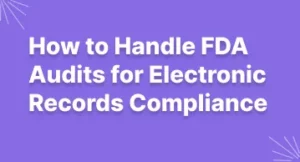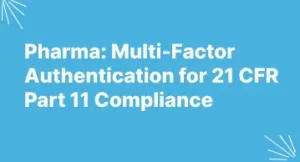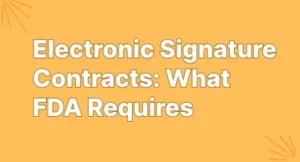2023: Unlock Career Growth w/ The Top Pharma & Biotech Events
Introduction – Why Addressing Quality and Compliance Oversights is Key to Pharma Success
The success of any business in the pharmaceutical industry relies heavily on its ability to navigate the ever-changing regulations that are required for quality and compliance. As a result, it is essential for pharmaceutical companies to remain up-to-date on these regulations and maintain a high level of compliance within their organization. This guide provides an overview of the top six quality and compliance oversights that pharma companies must address in order to remain successful.
Key 1: Improving Internal Processes
Creating a smooth and efficient internal process is essential for the success of any pharmaceutical company. By having well-established protocols and procedures in place, pharma companies are able to ensure that their operations run smoothly while not compromising the quality of their products.
When it comes to internal processes, it is important to consider factors such as resource management, process efficiency, and safety. Properly managing resources can help to reduce costs while still maintaining a high level of quality. Additionally, ensuring that operations are running efficiently can help to minimize delays and disruptions which can result in costly setbacks. Lastly, establishing safety protocols is essential to protecting employees and customers from any potential risks.
Evidence shows that investing in internal processes can lead to improved customer satisfaction, greater employee engagement, and increased efficiency. Companies that invest in their internal processes have been shown to achieve higher profits in the long-run. Moreover, these companies are more likely to succeed in the competitive pharma industry by avoiding costly oversights and mistakes.
Ensuring Data Security in Pharma
Data security is essential for any pharma company, as customer data must be kept secure and confidential at all times in order to comply with industry regulations and laws. Failing to do so not only puts customers at risk of fraud or theft, but also carries hefty fines and penalties.
Some of the key measures that should be taken to ensure data security include:
- Implementing an encryption system that makes customer data difficult to access (even by authorized personnel).
- Creating a secure network that contains customer data and other sensitive information.
- Implementing two-factor authentication whenever customer data is accessed.
- Regularly perform security audits on the database to detect any unauthorized access.
- Ensure that there are adequate access controls in place to limit who can access customer data.
- Monitor user access to customer data to ensure employees are not abusing their privileges.
By taking these steps, pharma companies can rest assured that customer data is safe and secure. Additionally, it is important to stay up to date with the latest security trends and technologies, as this will help protect customer data even further.
Ensuring that regulatory and compliance changes are adequately documented is a crucial part of protecting pharma companies from liability and fines. It is essential to maintain accurate records of all regulatory and compliance changes, as this can help businesses defend themselves in the event of an investigation or audit.
Organizations should create policies and procedures for documenting all changes in the event of any disputes. Additionally, businesses should consider implementing an audit trail system that logs all regulatory and compliance changes, as this can improve transparency. Not only will this help demonstrate compliance with regulations but also provide useful information when responding to inquiries.
When it comes to documenting changes, communication is key. All personnel should be aware of any changes made to regulations or compliance standards. This includes providing documentation or summaries of changes to all departments. Providing regular training is another important factor for successful implementation. This can help personnel understand the changes and how they must adjust their practices.
Finally, organizations should conduct internal assessments and inspections to ensure that all regulatory and compliance changes have been properly documented. This can help identify any potential discrepancies or inaccuracies in documentation and allow organizations to make any necessary adjustments.
Understanding New Regulations
As we progress in the ever-evolving pharmaceutical industry, it is important to stay updated on the latest regulations and compliance requirements. These regulations can come from local, state, and federal governments. It is essential to have an understanding of these regulations in order to comply with them and avoid potential fines or other penalties.
To understand new regulations, pharma companies should monitor relevant news sources, websites, and publications. Additionally, attending seminars and workshops on regulations and compliance can help stay informed on the latest trends. Keeping up with regulatory updates from relevant government bodies can also help pharma companies stay ahead of the curve on changes to existing laws.
It is also important to note that some regulations require medical professionals and staff to receive special training. For example, the U.S. Drug Enforcement Administration (DEA) has its own set of rules and regulations around controlled substances. Pharmacy staff must be trained and educated to properly deal with DEA-controlled substances and be familiar with the regulations and implications.
Understanding and complying with regulations and compliance measures can help ensure that all operations adhere to standards set by the industry, government, and other organizations. By staying up to date and aware of industry regulations, pharma companies can prevent any issues that could arise due to non-compliance.
Key 5: Implementing Compliance Training
Compliance training is a crucial component for any pharmaceutical company, allowing employees to stay up-to-date with regulations and protocols. This ensures operations and practices are compliant with the rules and standards set by governing bodies. Companies must find a way to effectively train their employees on regulations and compliance to ensure premium safety and performance.
To do this, start by designing a comprehensive and concise training program. This program should encompass all of the training objectives and topics that need to be taught throughout the duration of the training. Breakdown each topic with examples and information on the current regulations, processes, and procedures. By doing this, the company will be able to ensure its employees are receiving well rounded knowledge.
Secondly, provide interactive learning sessions. Use videos, quizzes, activities, and simulations to give employees a chance to apply the knowledge gained during the training. Active participation can help employees learn better, boosting engagement and understanding of the material.
Lastly, ensure regulating authorities are aware of the training program implemented. When evaluating a company’s compliance training program, regulators will assess the program’s depth and effectiveness. It’s important for pharma companies to be able to provide evidence of effective training initiatives in order to be compliant.
Implementing an effective training program is key to ensuring compliance within the pharma industry. By designing a comprehensive program, providing interactive learning sessions, and making regulators aware of the program, companies can create an environment of regulatory and quality assurance.
Key 6: Quality Assurance and Control
Quality assurance and control in pharma is essential for producing safe, effective, and reliable products. Quality assurance helps ensure that all products meet safety, quality, and efficacy standards, while quality control ensures any irregularities or deficiencies are identified and corrected. To establish effective measures for quality assurance and control, pharma companies should:
- Develop and implement Quality Assurance Systems – These systems should include standard operating procedures (SOPs) to help ensure consistent product quality.
- Monitor and Analyze Data – Regular monitoring and analysis of product data can reveal potential irregularities or deficiencies that can be addressed quickly.
- Conduct Audits – Periodic, independent audits across the entire supply chain can identify areas that need improvement or do not adhere to regulations.
- Investigate Nonconforming Products – Anytime a product does not meet regulatory requirements, it should be reviewed and investigated to identify the root cause.
By following these guidelines and steps, pharma companies can develop strong quality assurance and control plans that help minimize risks, guarantee product quality, and ensure compliance with regulatory standards.
The pharma industry is subject to stringent oversight from a variety of regulations and compliance issues. To avoid costly penalties, mistakes, and poor reputation, it is essential that pharma companies prioritize dealing with any oversights that may occur. This guide has outlined the top 6 quality and compliance oversights and how they can be addressed.
Improving internal processes is key to ensure efficient operations. Ensuring data security is also paramount to protect customer information and adhere to regulations. Documenting changes is an important step to regulatory compliance and should be done consistently. Understanding new regulations is also critical to staying compliant and to avoid penalties. Implementing compliance training for employees can help create an effective system of ensuring all regulations are known and adhered to. Finally, consistent quality assurance and control measures must be put in place and regularly reviewed.
In conclusion, addressing quality and compliance oversights is essential to a successful and compliant pharma business. By following the guidelines outlined in this guide, pharma companies can develop strong systems and procedures to ensure quality and compliance standards. Regular reviews and monitoring should be conducted to ensure that any issues or oversights are quickly identified and addressed. It is only by properly managing quality and compliance that companies can maximize their success and profitability.
FAQs
1. What is the importance of addressing quality and compliance oversights in the pharma industry?
Quality and compliance oversights in the pharmaceutical industry are essential for successful operations, and ensure that businesses are meeting industry standards and regulations. Adopting efficient internal processes, properly documenting changes, understanding new regulations, and implementing compliance training are all key components to reducing oversights and avoiding costly mistakes.
2. How can pharma companies implement efficient internal processes?
Pharma companies should invest in data-driven technology solutions that can help track progress and ensure accuracy and timeliness of processes. Additionally, it is important to streamline processes and procedures to avoid wasted time and resources.
3. Why is data security so important in the pharma industry?
Patient information and medical records must be handled with the utmost care in the pharma industry. To ensure that customer information is secure, businesses should invest in comprehensive security protocols, such as encryption and two-step authentication.
4. What steps should be taken to ensure that all regulatory and compliance changes are properly documented?
It is essential to keep up to date records of all regulatory and compliance changes to ensure that businesses are compliant. Pharma companies should maintain a library of updated documents, use automated system reminders to alert employees of changes, and retain back-up copies of documents as needed.
5. How can pharma companies ensure they are in compliance with new regulations?
To ensure compliance with new regulations, pharma companies should have a system in place to identify and understand new regulations as they come into effect. Employees should also be regularly trained on understanding, adhering to, and applying new laws and regulations.
6. What strategies should be used for creating and implementing effective training for employees on regulations and compliance?
Regulatory and compliance training should include comprehensive learning materials and activities, focus on the use and application of this knowledge, and leverage existing resources and tools. Regular check-ins will ensure employees are maintaining an understanding of the latest changes.
7. How do we establish appropriate measures for quality assurance and control?
Quality assurance and control measures are helpful in detecting potential issues that can lead to patient safety risks or product defects. Companies should implement a range of methods, such as visual inspections, data analysis, and process checks.







